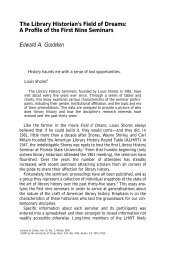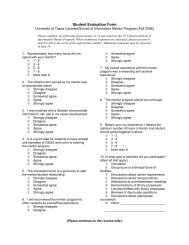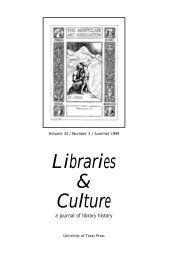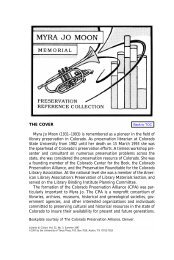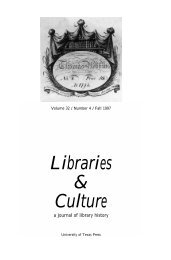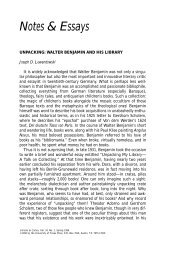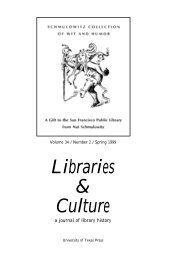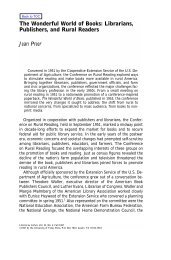Full issue (pdf file, 973 kb) - School of Information - The University of ...
Full issue (pdf file, 973 kb) - School of Information - The University of ...
Full issue (pdf file, 973 kb) - School of Information - The University of ...
Create successful ePaper yourself
Turn your PDF publications into a flip-book with our unique Google optimized e-Paper software.
the Special Libraries Association, but more analytical is Elin B.<br />
Christianson’s Daniel Nash Handy and the Special Library Movement. 111 Irene<br />
Farkas-Conn’s work on the history <strong>of</strong> the American Society for<br />
<strong>Information</strong> Science is also helpful. 112 Abbreviated histories <strong>of</strong> other pr<strong>of</strong>essional<br />
associations can be found scattered throughout the scholarly<br />
periodical literature. 113<br />
General Historical Studies <strong>of</strong> the Pr<strong>of</strong>ession and Its Activities<br />
Scores <strong>of</strong> good American library history books published in the last<br />
half century exist that cross the categories <strong>of</strong> literature I list above. Here<br />
I mention either the best or the most useful, because at the time <strong>of</strong> this<br />
writing, American library history lacked anything better. In the area <strong>of</strong><br />
censorship, I have already mentioned Geller and Robbins, but readers<br />
should also consult Marjorie Fiske’s germinal Book Selection and Censorship,<br />
which analyzes censoring practices <strong>of</strong> California school and public librarians<br />
in the 1950s. 114 L. B. Woods demonstrates that censorship imposed<br />
from outside the pr<strong>of</strong>ession is every bit as effective as censorship effected<br />
from the inside. 115 Pam Richards’s analysis <strong>of</strong> the World War II Allied-<br />
German rivalry for scientific information is a model case study <strong>of</strong> comparative<br />
history. 116 Dave Kaser covers a different war, a different time, as<br />
do I with An Active Instrument for Propaganda, which looks at public library<br />
activity on behalf <strong>of</strong> the state during World War I. 117 Kathleen Molz<br />
addresses National Planning for Library Service, 1935–1975, while Fred<br />
Stielow and Mary Lee Bundy have edited a series <strong>of</strong> essays covering<br />
Activism in American Librarianship, 1962–1<strong>973</strong>. 118 Ed Holley and Bob<br />
Schremser contribute a series <strong>of</strong> interviews with members <strong>of</strong> the nation’s<br />
library community who were integral to the passage <strong>of</strong> the Library<br />
Services and Construction Act <strong>of</strong> 1964, which has had a significant<br />
impact on the practice <strong>of</strong> librarianship ever since. 119<br />
Several works cover the library as a pr<strong>of</strong>ession and selectively draw<br />
upon its history for evidence to support conclusions. Works by Lloyd J.<br />
Houser and Alvin Schrader, George E. Bennett, and Michael F. Winter<br />
are worthwhile; so is Mike Harris and Stan Hannah’s Into the Future: <strong>The</strong><br />
Foundations <strong>of</strong> Library and <strong>Information</strong> Services in the Post-Industrial Era. 120 <strong>The</strong><br />
best <strong>of</strong> the set, however, is Andrew Abbott’s System <strong>of</strong> Pr<strong>of</strong>essions, which<br />
uses the concept <strong>of</strong> pr<strong>of</strong>essional jurisdiction to compare the history <strong>of</strong><br />
librarianship with several other pr<strong>of</strong>essions. 121<br />
Print Culture History<br />
As I prepared this essay I had occasion to read an article entitled “<strong>The</strong><br />
Business <strong>of</strong> Reading in Nineteenth-Century America: <strong>The</strong> New York<br />
19



